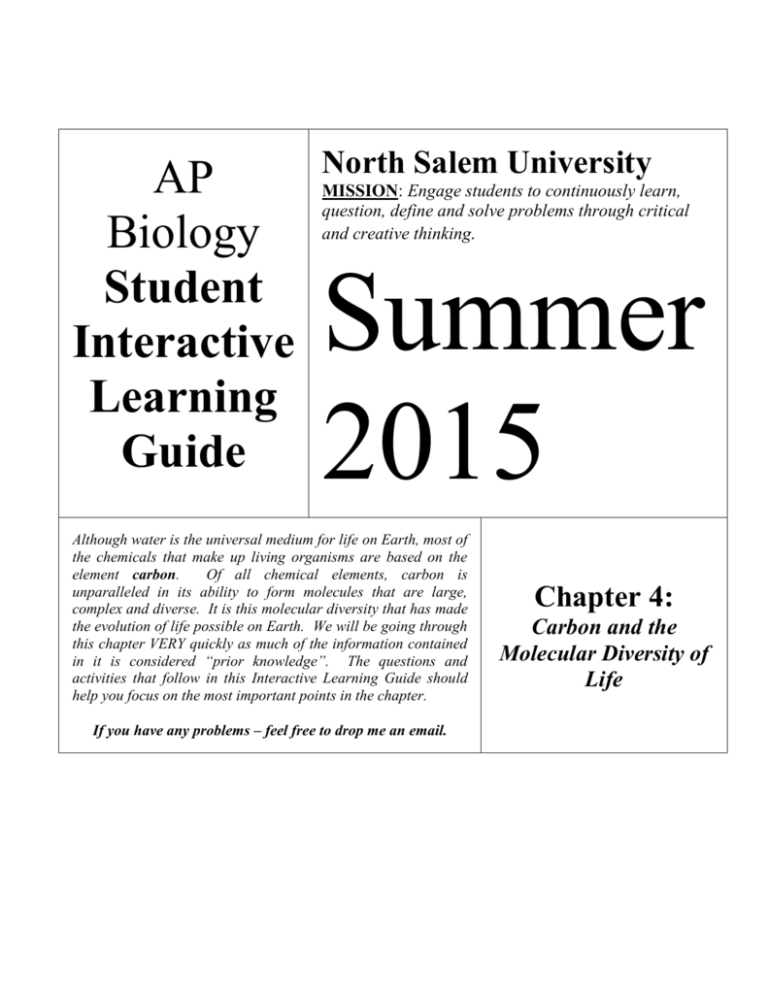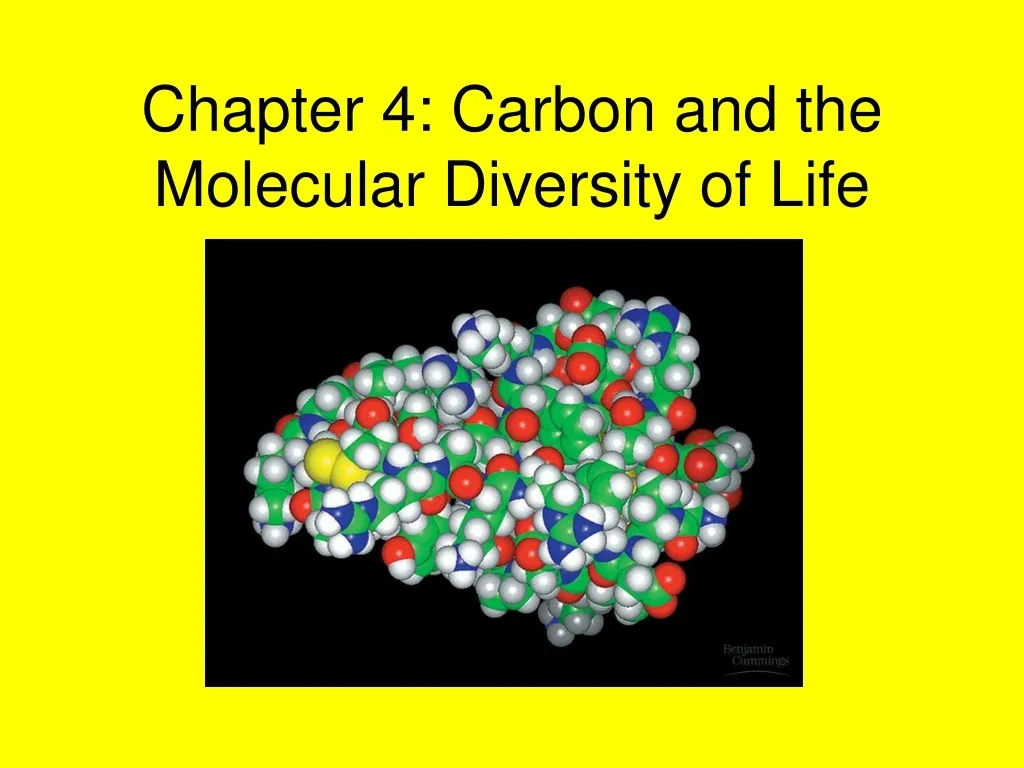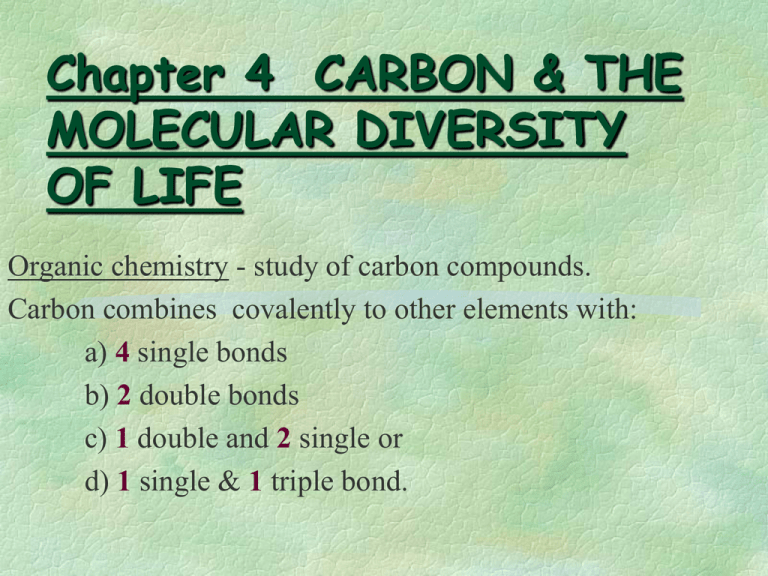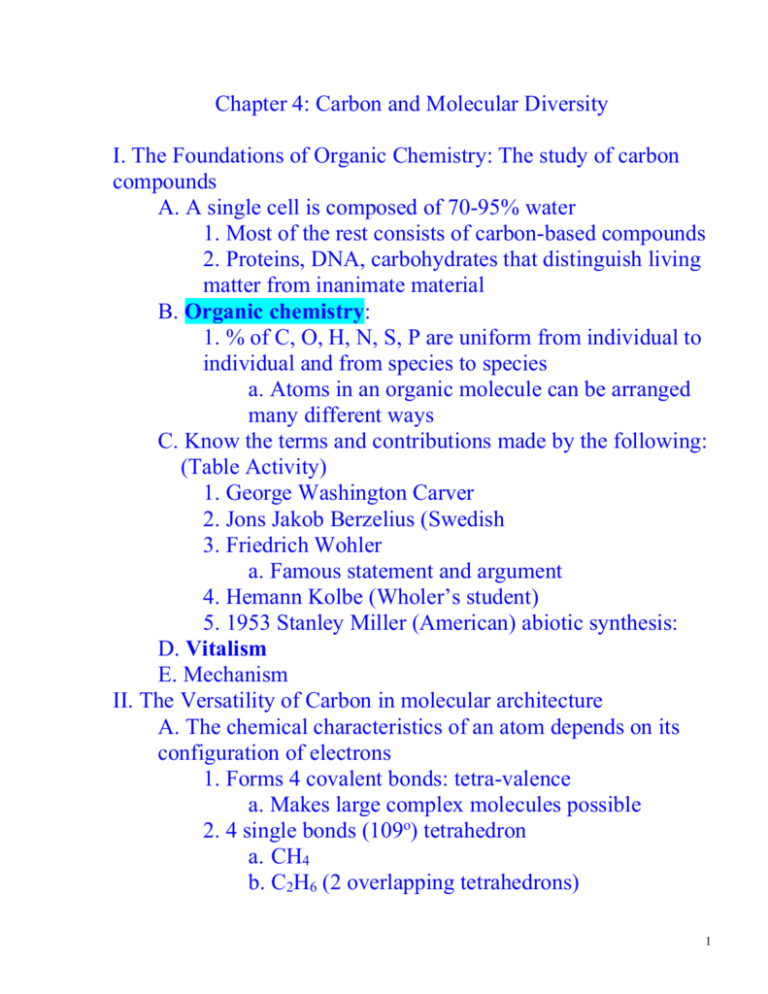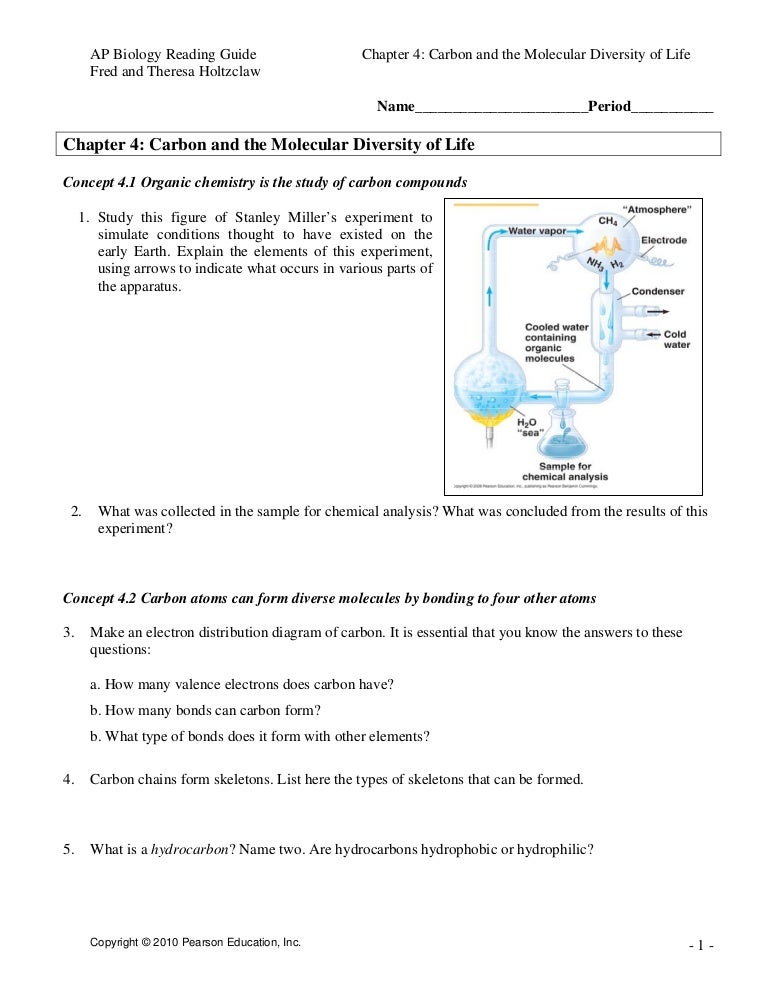Chapter 4 Carbon And The Molecular Diversity Of Life
Chapter 4 Carbon And The Molecular Diversity Of Life - Web ch3 methyl group oh hydroxyl group c=o carbonyl group cooh carboxyl group nh2 amino group sh • carbon atoms can form diverse molecules by bonding to four other atoms. Carbon has little tendency to form ionic bonds by losing or gaining 4. University university of south carolina conservation biology (biol 571) students. See timestamps below :) this is a narrated lecture that corresponds with chapter 4 of the campbell biology. Web miller concluded that organic molecules, a first step in the origin of life, may have been synthesized abiotically on the early earth. Carbon's atomic number is 6. Web biology 111 ppcc general college biology i chapter 4 carbon and the molecular diversity of life vocabulary: • a few chemical groups are key to molecular. Web created by martinezcynthia key concepts:
Organic chemistry is the study of carbon compounds •organic chemistry is the study of carbon compounds i.e. University university of south carolina conservation biology (biol 571) students. Web videos shown:atomic carbon bohr model si. What was collected in the sample for. Web biology 111 ppcc general college biology i chapter 4 carbon and the molecular diversity of life vocabulary: 2 in the first electron shell and 4 in the second shell. Web a variety of simple organic compounds could be spontaneously synthesized from components in earth's primitive atmosphere. See timestamps below :) this is a narrated lecture that corresponds with chapter 4 of the campbell biology. Explain the elements of this experiment, using arrows to indicate what occurs in various parts of the apparatus. Carbon is an unusual atom in that it can form multiple bonds.
After attending lectures and studying the chapter… Web concept 4.2 carbon atoms can form diverse molecules by bonding to four other atoms. Explain the elements of this experiment, using arrows to indicate what occurs in various parts of the apparatus. Web a variety of simple organic compounds could be spontaneously synthesized from components in earth's primitive atmosphere. Web miller concluded that organic molecules, a first step in the origin of life, may have been synthesized abiotically on the early earth. • a few chemical groups are key to molecular. · the overall percentages of the major elements of life. Web videos shown:atomic carbon bohr model si. Carbon has little tendency to form ionic bonds by losing or gaining 4. Web chapter 4 carbon and the molecular diversity of life lecture outline.
Chapter 4 Carbon and the Molecular Diversity of Life YouTube
• a few chemical groups are key to molecular. A carbon atom has a total of 6 electrons: What was collected in the sample for. List here the types of skeletons that can be formed. Web ch3 methyl group oh hydroxyl group c=o carbonyl group cooh carboxyl group nh2 amino group sh
Chapter 4 Carbon and the Molecular Diversity of Life
Web a variety of simple organic compounds could be spontaneously synthesized from components in earth's primitive atmosphere. May form rings, chains, or combo of two. Please click the link below to download the biology slides from the campbell’s biology, 7th edition textbook. • carbon atoms can form diverse molecules by bonding to four other atoms. Which statement is not true?
PPT Chapter 4 Carbon and the Molecular Diversity of Life PowerPoint
Web · organic compounds can range from simple molecules, such as co2 or ch4, to complex molecules such as proteins, which may weigh more than 100,000 daltons. Web a variety of simple organic compounds could be spontaneously synthesized from components in earth's primitive atmosphere. Web videos shown:atomic carbon bohr model si. Web created by martinezcynthia key concepts: Organic molecule, inorganic.
Carbon and the molecular diversity of life. (Chapter 4) презентация
Web chapter 4 carbon and the molecular diversity of life lecture outline. A carbon atom has a total of 6 electrons: 2 in the first electron shell and 4 in the second shell. Make possible diversity of organisms that have evolved on earth. Web miller concluded that organic molecules, a first step in the origin of life, may have been.
Chapter 4 CARBON AND THE MOLECULAR DIVERSITY OF LIFE
See timestamps below :) this is a narrated lecture that corresponds with chapter 4 of the campbell biology. Web videos shown:atomic carbon bohr model si. Web created by martinezcynthia key concepts: Web the properties of the molecule. • carbon atoms can form diverse molecules by bonding to four other atoms.
Chapter 4 Carbon and the Molecular Diversity of Life
Carbon has little tendency to form ionic bonds by losing or gaining 4. Web a variety of simple organic compounds could be spontaneously synthesized from components in earth's primitive atmosphere. · the overall percentages of the major elements of life. Web videos shown:atomic carbon bohr model si. Explain the elements of this experiment, using arrows to indicate what occurs in.
Biology Chapter 4 Carbon and the Molecular Diversity of Life YouTube
After attending lectures and studying the chapter… Study this figure of stanley miller’s experiment to simulate conditions thought to have existed on the early earth. Carbon enters the biosphere through the action of plants. Web created by martinezcynthia key concepts: Web terms in this set (72) carbon.
Chapter 4 Carbon and Molecular Diversity
Organic molecule, inorganic molecule, hydrocarbon, isomer, structural isomer, geometric isomers, enantiomers, functional groups, adenosine triphosphate (atp) objectives: Web videos shown:atomic carbon bohr model si. University university of south carolina conservation biology (biol 571) students. Organic chemistry is the study of carbon compounds •organic chemistry is the study of carbon compounds i.e. This means that it has __________ electrons.
Chapter 4 carbon and the molecular diversity of life
Carbon has little tendency to form ionic bonds by losing or gaining 4. • a few chemical groups are key to molecular. Please click the link below to download the biology slides from the campbell’s biology, 7th edition textbook. Organic compounds •most organic compounds contain hydrogen atoms in addition to carbon atoms •carbon. Web terms in this set (72) carbon.
Chapter 4 carbon and the molecular diversity of life
What was collected in the sample for. Web concept 4.2 carbon atoms can form diverse molecules by bonding to four other atoms. Web a variety of simple organic compounds could be spontaneously synthesized from components in earth's primitive atmosphere. Web hello fellow stem students! • a few chemical groups are key to molecular.
• Carbon Atoms Can Form Diverse Molecules By Bonding To Four Other Atoms.
A carbon atom has a total of 6 electrons: Which statement is not true? Web · organic compounds can range from simple molecules, such as co2 or ch4, to complex molecules such as proteins, which may weigh more than 100,000 daltons. Study this figure of stanley miller’s experiment to simulate conditions thought to have existed on the early earth.
After Attending Lectures And Studying The Chapter…
May form rings, chains, or combo of two. Web chapter 4 carbon and the molecular diversity of life lecture outline. Web biology 111 ppcc general college biology i chapter 4 carbon and the molecular diversity of life vocabulary: Organic chemistry is the study of carbon compounds •organic chemistry is the study of carbon compounds i.e.
Web Terms In This Set (72) Carbon.
Web ch3 methyl group oh hydroxyl group c=o carbonyl group cooh carboxyl group nh2 amino group sh · the overall percentages of the major elements of life. Organic compounds •most organic compounds contain hydrogen atoms in addition to carbon atoms •carbon. Web the properties of the molecule.
Web These Included Simple Compounds, Such As Formaldehyde (Ch2O) And Hydrogen Cyanide (Hcn), And More Complex Molecules, Such As Amino Acids And Long Chains Of Carbon And Hydrogen Known As Hydrocarbons.
Web hello fellow stem students! Web created by martinezcynthia key concepts: Explain the elements of this experiment, using arrows to indicate what occurs in various parts of the apparatus. 2 in the first electron shell and 4 in the second shell.

